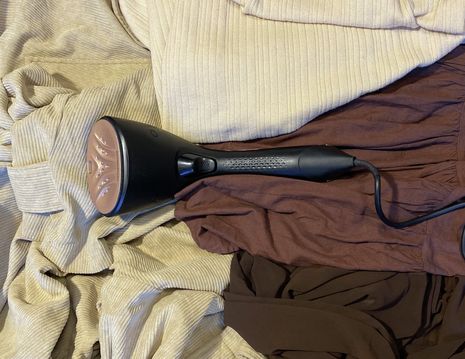‘Clothes are just clothes, and creases are just creases’: are creases really back in?
Creased clothing seems to be in style, but is this a trend cycle that translates well for everyone?

It’s 6 pm, and I have a formal in an hour’s time. Though in my second year, and having attended many a formal throughout this period, the peculiarity of the event is not yet lost on me. Overflowing gowns, too much cutlery and halls with wedding cake ceilings all form part of one of Cambridge’s most illustrious experiences. Because of this, preparing for the event often takes longer than the dinner itself. Here lies my current dilemma. My dress is creased.
This isn’t the first time I’ve run into a wrinkle. My first port of call is usually my best friend, Aamina, and her ever-trusty steamer. Though I have an iron of my own, its tendency to burn my clothes (rather, my tendency to misread the temperature on the dial) means that I’ve become entirely dependent on that burn-proof puff of steam to press out any flaws. It’s little work for lots of gains. But she’s not yet back from her lecture, and I’ve still got a face mask on, so times are looking desperate.
Clothes are just clothes, and creases are just creases
In the end, I managed to steam my dress in just enough time. It occurred to me during this process that I’ve found myself in this exact position a lot this year. Staring at creases as though I can will them away telepathically; mentally discarding outfit options if it means I can have a lie-in without having to deal with an unironed piece. I’m sure this is a universal experience. In a university obsessed with appearances, even in solitary activities like going to the library, I’m positive that the sight of wrinkled clothing has ruined many outfit possibilities. Is this obsession unfounded?
As ever, high fashion turns the wheel, and the runways of this year’s fashion weeks have been led with intentional creases. Take Prada’s Spring 2023 Ready to Wear collection. It’s abundant with pulled-apart stitching and crinkles that appear to have been purposely ironed in instead of out. The show pays homage to the dishevelled simplicity of everyday life. The message is that wrinkles are a map of all the places we’ve been by the end of the day, signifying clothes that have been truly lived in. The current fashion zeitgeist is all for this. Second-hand clothing is favoured in part because it allows us to share in items that have already led a life of their own.
Whilst this all sounds good, it also seems somewhat ironic. For a movement intent on effortlessness, pro-creasers seem very cognizant of the image their wrinkles create. It’s reminiscent of displays of ease that continue to connote wealth; a nonchalant attitude that is deemed more culturally appropriate than outright boasts of affluence. Of course, not everything is a statement. In the past, I too have embraced crinkled clothing because, in the end: does it really matter? However, to those who aren’t aware of an aesthetic shift towards accepting creases, choices that embrace them are often seen as lazy and unkept, even if Prada’s Raf Simons believes them to be intentional “gestures of error”.
I want to reiterate that ultimately, it really does not matter. Clothes are just clothes, and creases are just creases. Believing them to be emblematic of any specific image is a downward spiral into constant self-surveillance that will make you disengage from fashion entirely. So, if you’re counting on that extra 10 minutes in bed, keep doing so: embrace the crease, if you so desire. In the meantime, I know I’ll still be knocking on Aamina’s door for her steamer, but I’m sure these will be reduced encounters. For that, I know she’ll be grateful.
 News / Eight Cambridge researchers awarded €17m in ERC research grants27 December 2025
News / Eight Cambridge researchers awarded €17m in ERC research grants27 December 2025 News / Clare Hall spent over £500k opposing busway 24 December 2025
News / Clare Hall spent over £500k opposing busway 24 December 2025 Comment / League tables do more harm than good26 December 2025
Comment / League tables do more harm than good26 December 2025 Comment / The ‘class’ of Cambridge24 December 2025
Comment / The ‘class’ of Cambridge24 December 2025 News / Caius mourns its tree-mendous loss23 December 2025
News / Caius mourns its tree-mendous loss23 December 2025








